Microsoft 70-764 Exam Practice Questions (P. 4)
- Full Access (342 questions)
- Six months of Premium Access
- Access to one million comments
- Seamless ChatGPT Integration
- Ability to download PDF files
- Anki Flashcard files for revision
- No Captcha & No AdSense
- Advanced Exam Configuration
Question #31
DRAG DROP -
Note: This question is part of a series of questions that use the same scenario. For your convenience, the scenario is repeated in each question. Each question presents a different goal and answer choices, but the text of the scenario is exactly the same in each question in this series.
You have five servers that run Microsoft Windows 2012 R2. Each server hosts a Microsoft SQL Server instance. The topology for the environment is shown in the following diagram.
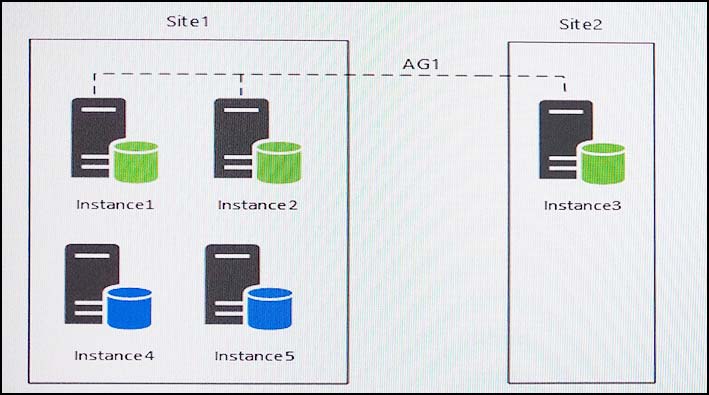
You have an Always On Availability group named AG1. The details for AG1 are shown in the following table.

Instance1 experiences heavy read-write traffic. The instance hosts a database named OperationsMain that is four terabytes (TB) in size. The database has multiple data files and filegroups. One of the filegroups is read_only and is half of the total database size.
Instance4 and Instance5 are not part of AG1. Instance4 is engaged in heavy read-write I/O.
Instance5 hosts a database named StagedExternal. A nightly BULK INSERT process loads data into an empty table that has a rowstore clustered index and two nonclustered rowstore indexes.
You must minimize the growth of the StagedExternal database log file during the BULK INSERT operations and perform point-in-time recovery after the BULK
INSERT transaction. Changes made must not interrupt the log backup chain.
You plan to add a new instance named Instance6 to a datacenter that is geographically distant from Site1 and Site2. You must minimize latency between the nodes in AG1.
All databases use the full recovery model. All backups are written to the network location \\SQLBackup\. A separate process copies backups to an offsite location.
You should minimize both the time required to restore the databases and the space required to store backups. The recovery point objective (RPO) for each instance is shown in the following table.
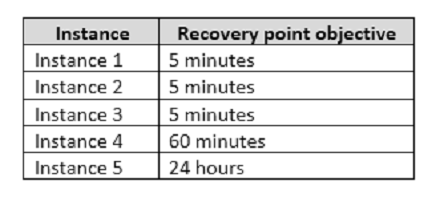
Full backups of OperationsMain take longer than six hours to complete. All SQL Server backups use the keyword COMPRESSION.
You plan to deploy the following solutions to the environment. The solutions will access a database named DB1 that is part of AG1.
✑ Reporting system: This solution accesses data inDB1with a login that is mapped to a database user that is a member of the db_datareader role. The user has
EXECUTE permissions on the database. Queries make no changes to the data. The queries must be load balanced over variable read-only replicas.
✑ Operations system: This solution accesses data inDB1with a login that is mapped to a database user that is a member of the db_datareader and db_datawriter roles. The user has EXECUTE permissions on the database. Queries from the operations system will perform both DDL and DML operations.
The wait statistics monitoring requirements for the instances are described in the following table.

You need to configure a new replica of AG1 on Instance6.
How should you complete the Transact-SQL statement? To answer, drag the appropriate Transact-SQL statements to the correct locations. Each Transact-SQL segment may be used once, more than once, or not at all. You may need to drag the split bar between panes or scroll to view content.
Select and Place:
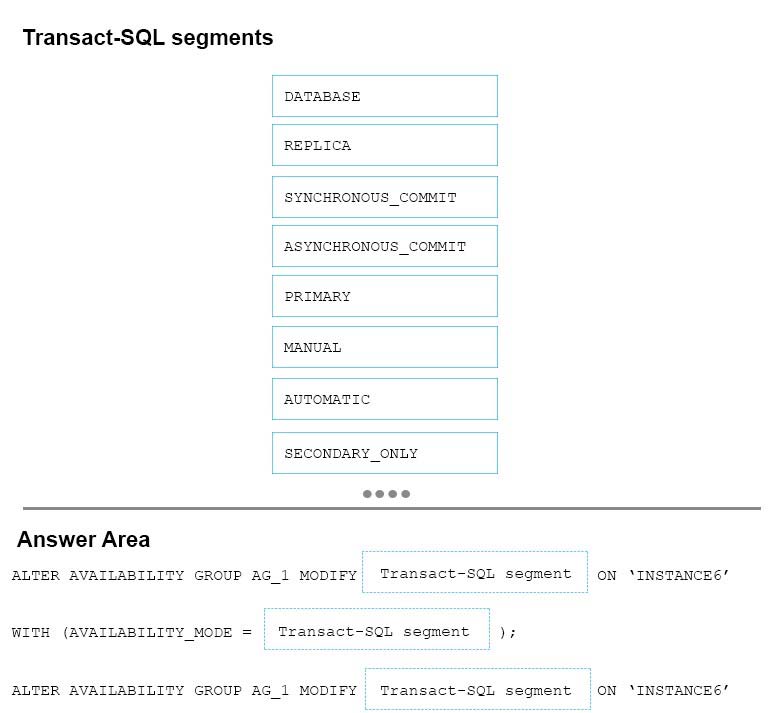
Note: This question is part of a series of questions that use the same scenario. For your convenience, the scenario is repeated in each question. Each question presents a different goal and answer choices, but the text of the scenario is exactly the same in each question in this series.
You have five servers that run Microsoft Windows 2012 R2. Each server hosts a Microsoft SQL Server instance. The topology for the environment is shown in the following diagram.

You have an Always On Availability group named AG1. The details for AG1 are shown in the following table.

Instance1 experiences heavy read-write traffic. The instance hosts a database named OperationsMain that is four terabytes (TB) in size. The database has multiple data files and filegroups. One of the filegroups is read_only and is half of the total database size.
Instance4 and Instance5 are not part of AG1. Instance4 is engaged in heavy read-write I/O.
Instance5 hosts a database named StagedExternal. A nightly BULK INSERT process loads data into an empty table that has a rowstore clustered index and two nonclustered rowstore indexes.
You must minimize the growth of the StagedExternal database log file during the BULK INSERT operations and perform point-in-time recovery after the BULK
INSERT transaction. Changes made must not interrupt the log backup chain.
You plan to add a new instance named Instance6 to a datacenter that is geographically distant from Site1 and Site2. You must minimize latency between the nodes in AG1.
All databases use the full recovery model. All backups are written to the network location \\SQLBackup\. A separate process copies backups to an offsite location.
You should minimize both the time required to restore the databases and the space required to store backups. The recovery point objective (RPO) for each instance is shown in the following table.

Full backups of OperationsMain take longer than six hours to complete. All SQL Server backups use the keyword COMPRESSION.
You plan to deploy the following solutions to the environment. The solutions will access a database named DB1 that is part of AG1.
✑ Reporting system: This solution accesses data inDB1with a login that is mapped to a database user that is a member of the db_datareader role. The user has
EXECUTE permissions on the database. Queries make no changes to the data. The queries must be load balanced over variable read-only replicas.
✑ Operations system: This solution accesses data inDB1with a login that is mapped to a database user that is a member of the db_datareader and db_datawriter roles. The user has EXECUTE permissions on the database. Queries from the operations system will perform both DDL and DML operations.
The wait statistics monitoring requirements for the instances are described in the following table.

You need to configure a new replica of AG1 on Instance6.
How should you complete the Transact-SQL statement? To answer, drag the appropriate Transact-SQL statements to the correct locations. Each Transact-SQL segment may be used once, more than once, or not at all. You may need to drag the split bar between panes or scroll to view content.
Select and Place:

Correct Answer:
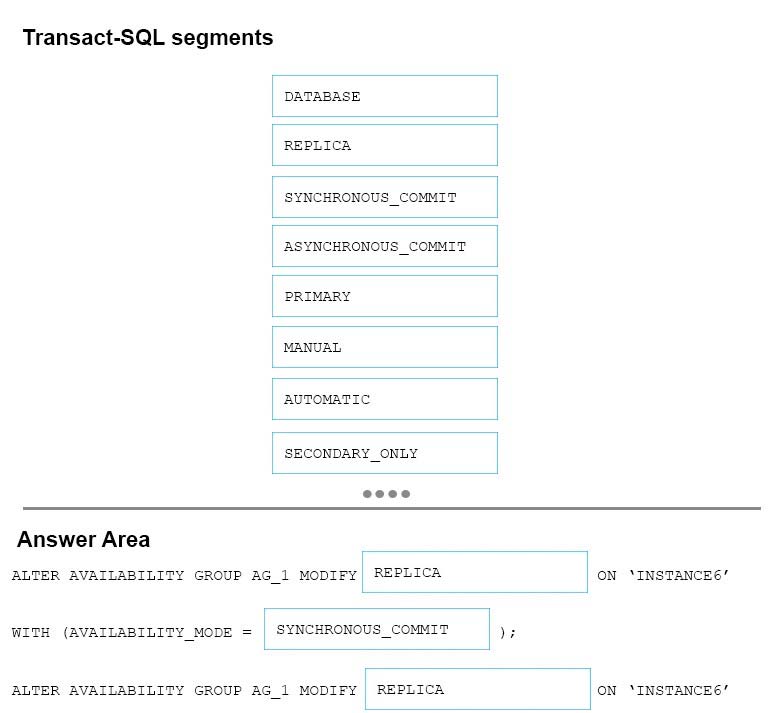
Scenario: You plan to add a new instance named Instance6 to a datacenter that is geographically distant from Site1 and Site2. You must minimize latency between the nodes in AG1.
Box 1: REPLICA -
MODIFY REPLICA ON modifies any of the replicas ofthe availability group.
Box 2: SYNCHRONOUS_COMMIT -
You must minimize latency between the nodes in AG1
AVAILABILITY_MODE = { SYNCHRONOUS_COMMIT | ASYNCHRONOUS_COMMIT }
Specifies whether the primary replica has to wait for the secondary availability group to acknowledge the hardening (writing) of the log records to disk before the primary replica can commit the transaction on a given primary database.
FAILOVER AUTOMATIC (box 4) requires SYNCHRONOUS_COMMIT
Box 3: REPLICA -
MODIFY REPLICA ON modifies any of the replicas of the availability group.
Box 4: AUTOMATIC -
You must minimize latency between the nodes in AG1
FAILOVER_MODE = { AUTOMATIC | MANUAL }
Specifies the failover mode of the availability replica that you are defining.
FAILOVER_MODE is required in the ADD REPLICA ON clause and optional in the MODIFY REPLICA ON clause.
AUTOMATIC enables automatic failover. AUTOMATIC is supported only if you also specify AVAILABILITY_MODE = SYNCHRONOUS_COMMIT.
References: https://docs.microsoft.com/en-us/sql/t-sql/statements/alter-availability-group-transact-sql

Scenario: You plan to add a new instance named Instance6 to a datacenter that is geographically distant from Site1 and Site2. You must minimize latency between the nodes in AG1.
Box 1: REPLICA -
MODIFY REPLICA ON modifies any of the replicas ofthe availability group.
Box 2: SYNCHRONOUS_COMMIT -
You must minimize latency between the nodes in AG1
AVAILABILITY_MODE = { SYNCHRONOUS_COMMIT | ASYNCHRONOUS_COMMIT }
Specifies whether the primary replica has to wait for the secondary availability group to acknowledge the hardening (writing) of the log records to disk before the primary replica can commit the transaction on a given primary database.
FAILOVER AUTOMATIC (box 4) requires SYNCHRONOUS_COMMIT
Box 3: REPLICA -
MODIFY REPLICA ON modifies any of the replicas of the availability group.
Box 4: AUTOMATIC -
You must minimize latency between the nodes in AG1
FAILOVER_MODE = { AUTOMATIC | MANUAL }
Specifies the failover mode of the availability replica that you are defining.
FAILOVER_MODE is required in the ADD REPLICA ON clause and optional in the MODIFY REPLICA ON clause.
AUTOMATIC enables automatic failover. AUTOMATIC is supported only if you also specify AVAILABILITY_MODE = SYNCHRONOUS_COMMIT.
References: https://docs.microsoft.com/en-us/sql/t-sql/statements/alter-availability-group-transact-sql
send
light_mode
delete
Question #32
Note: This question is part of a series of questions that use the same scenario. For your convenience, the scenario is repeated in each question. Each question presents a different goal and answer choices, but the text of the scenario is exactly the same in each question in this series.
You have five servers that run Microsoft Windows 2012 R2. Each server hosts a Microsoft SQL Server instance. The topology for the environment is shown in the following diagram.
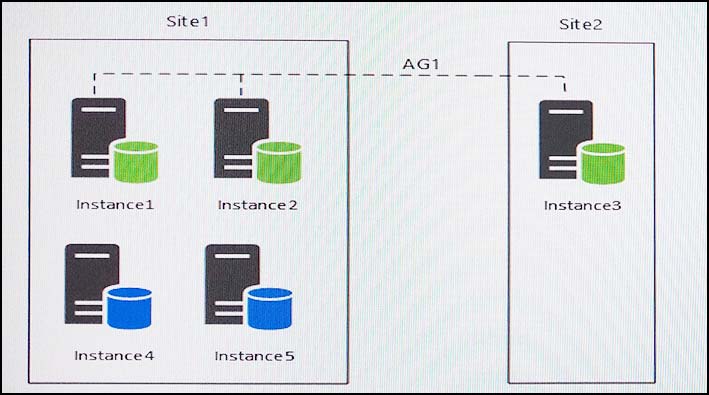
You have an Always On Availability group named AG1. The details for AG1 are shown in the following table.

Instance1 experiences heavy read-write traffic. The instance hosts a database named OperationsMain that is four terabytes (TB) in size. The database has multiple data files and filegroups. One of the filegroups is read_only and is half of the total database size.
Instance4 and Instance5 are not part of AG1. Instance4 is engaged in heavy read-write I/O.
Instance5 hosts a database named StagedExternal. A nightly BULK INSERT process loads data into an empty table that has a rowstore clustered index and two nonclustered rowstore indexes.
You must minimize the growth of the StagedExternal database log file during the BULK INSERT operations and perform point-in-time recovery after the BULK
INSERT transaction. Changes made must not interrupt the log backup chain.
You plan to add a new instance named Instance6 to a datacenter that is geographically distant from Site1 and Site2. You must minimize latency between the nodes in AG1.
All databases use the full recovery model. All backups are written to the network location \\SQLBackup\. A separate process copies backups to an offsite location.
You should minimize both the time required to restore the databases and the space required to store backups. The recovery point objective (RPO) for each instance is shown in the following table.
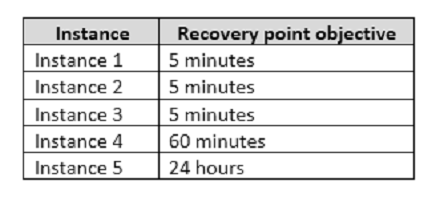
Full backups of OperationsMain take longer than six hours to complete. All SQL Server backups use the keyword COMPRESSION.
You plan to deploy the following solutions to the environment. The solutions will access a database named DB1 that is part of AG1.
✑ Reporting system: This solution accesses data inDB1with a login that is mapped to a database user that is a member of the db_datareader role. The user has
EXECUTE permissions on the database. Queries make no changes to the data. The queries must be load balanced over variable read-only replicas.
✑ Operations system: This solution accesses data inDB1with a login that is mapped to a database user that is a member of the db_datareader and db_datawriter roles. The user has EXECUTE permissions on the database. Queries from the operations system will perform both DDL and DML operations.
The wait statistics monitoring requirements for the instances are described in the following table.

You need to create a backup plan for Instance4.
Which backup plan should you create?
You have five servers that run Microsoft Windows 2012 R2. Each server hosts a Microsoft SQL Server instance. The topology for the environment is shown in the following diagram.

You have an Always On Availability group named AG1. The details for AG1 are shown in the following table.

Instance1 experiences heavy read-write traffic. The instance hosts a database named OperationsMain that is four terabytes (TB) in size. The database has multiple data files and filegroups. One of the filegroups is read_only and is half of the total database size.
Instance4 and Instance5 are not part of AG1. Instance4 is engaged in heavy read-write I/O.
Instance5 hosts a database named StagedExternal. A nightly BULK INSERT process loads data into an empty table that has a rowstore clustered index and two nonclustered rowstore indexes.
You must minimize the growth of the StagedExternal database log file during the BULK INSERT operations and perform point-in-time recovery after the BULK
INSERT transaction. Changes made must not interrupt the log backup chain.
You plan to add a new instance named Instance6 to a datacenter that is geographically distant from Site1 and Site2. You must minimize latency between the nodes in AG1.
All databases use the full recovery model. All backups are written to the network location \\SQLBackup\. A separate process copies backups to an offsite location.
You should minimize both the time required to restore the databases and the space required to store backups. The recovery point objective (RPO) for each instance is shown in the following table.

Full backups of OperationsMain take longer than six hours to complete. All SQL Server backups use the keyword COMPRESSION.
You plan to deploy the following solutions to the environment. The solutions will access a database named DB1 that is part of AG1.
✑ Reporting system: This solution accesses data inDB1with a login that is mapped to a database user that is a member of the db_datareader role. The user has
EXECUTE permissions on the database. Queries make no changes to the data. The queries must be load balanced over variable read-only replicas.
✑ Operations system: This solution accesses data inDB1with a login that is mapped to a database user that is a member of the db_datareader and db_datawriter roles. The user has EXECUTE permissions on the database. Queries from the operations system will perform both DDL and DML operations.
The wait statistics monitoring requirements for the instances are described in the following table.

You need to create a backup plan for Instance4.
Which backup plan should you create?
- AWeekly full backups, nightly differential. No transaction log backups are necessary.
- BWeekly full backups, nightly differential backups, transaction log backups every 5 minutes.
- CWeekly full backups, nightly differential backups, transaction log backups every 12 hours.
- DWeekly full backups, nightly differential backups, nightly transaction log backups.
Correct Answer:
B
From scenario: Instance4 and Instance5 are not part of AG1. Instance4 is engaged in heavy read-write I/O. The recovery point objective of Instancse4 is 60 minutes. RecoveryPoint Objectives are commonly described as the amount of data that was lost during the outage and recovery period.
References: http://sqlmag.com/blog/sql-server-recovery-time-objectives-and-recovery-point-objectives
B
From scenario: Instance4 and Instance5 are not part of AG1. Instance4 is engaged in heavy read-write I/O. The recovery point objective of Instancse4 is 60 minutes. RecoveryPoint Objectives are commonly described as the amount of data that was lost during the outage and recovery period.
References: http://sqlmag.com/blog/sql-server-recovery-time-objectives-and-recovery-point-objectives
send
light_mode
delete
Question #33
Note: This question is part of a series of questions that use the same scenario. For your convenience, the scenario is repeated in each question. Each question presents a different goal and answer choices, but the text of the scenario is exactly the same in each question in this series.
You have five servers that run Microsoft Windows 2012 R2. Each server hosts a Microsoft SQL Server instance. The topology for the environment is shown in the following diagram.
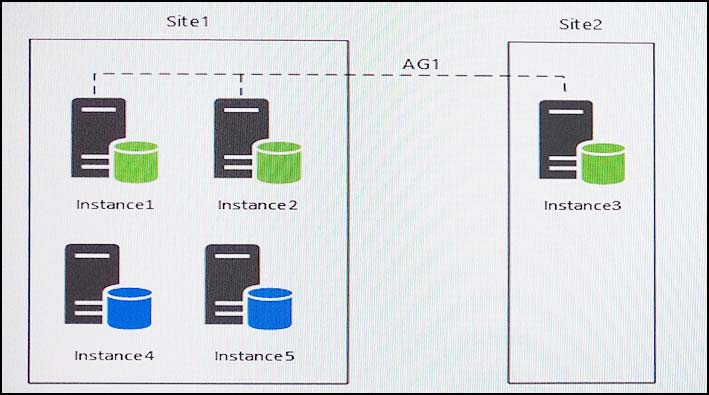
You have an Always On Availability group named AG1. The details for AG1 are shown in the following table.

Instance1 experiences heavy read-write traffic. The instance hosts a database named OperationsMain that is four terabytes (TB) in size. The database has multiple data files and filegroups. One of the filegroups is read_only and is half of the total database size.
Instance4 and Instance5 are not part of AG1. Instance4 is engaged in heavy read-write I/O.
Instance5 hosts a database named StagedExternal. A nightly BULK INSERT process loads data into an empty table that has a rowstore clustered index and two nonclustered rowstore indexes.
You must minimize the growth of the StagedExternal database log file during the BULK INSERT operations and perform point-in-time recovery after the BULK
INSERT transaction. Changes made must not interrupt the log backup chain.
You plan to add a new instance named Instance6 to a datacenter that is geographically distant from Site1 and Site2. You must minimize latency between the nodes in AG1.
All databases use the full recovery model. All backups are written to the network location \\SQLBackup\. A separate process copies backups to an offsite location.
You should minimize both the time required to restore the databases and the space required to store backups. The recovery point objective (RPO) for each instance is shown in the following table.
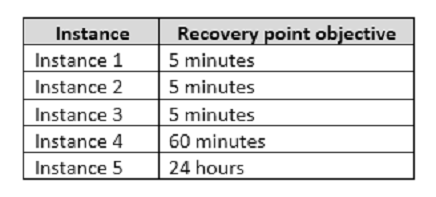
Full backups of OperationsMain take longer than six hours to complete. All SQL Server backups use the keyword COMPRESSION.
You plan to deploy the following solutions to the environment. The solutions will access a database named DB1 that is part of AG1.
✑ Reporting system: This solution accesses data inDB1with a login that is mapped to a database user that is a member of the db_datareader role. The user has
EXECUTE permissions on the database. Queries make no changes to the data. The queries must be load balanced over variable read-only replicas.
✑ Operations system: This solution accesses data inDB1with a login that is mapped to a database user that is a member of the db_datareader and db_datawriter roles. The user has EXECUTE permissions on the database. Queries from the operations system will perform both DDL and DML operations.
The wait statistics monitoring requirements for the instances are described in the following table.

You need to reduce the amount of time it takes to backup OperationsMain.
What should you do?
You have five servers that run Microsoft Windows 2012 R2. Each server hosts a Microsoft SQL Server instance. The topology for the environment is shown in the following diagram.

You have an Always On Availability group named AG1. The details for AG1 are shown in the following table.

Instance1 experiences heavy read-write traffic. The instance hosts a database named OperationsMain that is four terabytes (TB) in size. The database has multiple data files and filegroups. One of the filegroups is read_only and is half of the total database size.
Instance4 and Instance5 are not part of AG1. Instance4 is engaged in heavy read-write I/O.
Instance5 hosts a database named StagedExternal. A nightly BULK INSERT process loads data into an empty table that has a rowstore clustered index and two nonclustered rowstore indexes.
You must minimize the growth of the StagedExternal database log file during the BULK INSERT operations and perform point-in-time recovery after the BULK
INSERT transaction. Changes made must not interrupt the log backup chain.
You plan to add a new instance named Instance6 to a datacenter that is geographically distant from Site1 and Site2. You must minimize latency between the nodes in AG1.
All databases use the full recovery model. All backups are written to the network location \\SQLBackup\. A separate process copies backups to an offsite location.
You should minimize both the time required to restore the databases and the space required to store backups. The recovery point objective (RPO) for each instance is shown in the following table.

Full backups of OperationsMain take longer than six hours to complete. All SQL Server backups use the keyword COMPRESSION.
You plan to deploy the following solutions to the environment. The solutions will access a database named DB1 that is part of AG1.
✑ Reporting system: This solution accesses data inDB1with a login that is mapped to a database user that is a member of the db_datareader role. The user has
EXECUTE permissions on the database. Queries make no changes to the data. The queries must be load balanced over variable read-only replicas.
✑ Operations system: This solution accesses data inDB1with a login that is mapped to a database user that is a member of the db_datareader and db_datawriter roles. The user has EXECUTE permissions on the database. Queries from the operations system will perform both DDL and DML operations.
The wait statistics monitoring requirements for the instances are described in the following table.

You need to reduce the amount of time it takes to backup OperationsMain.
What should you do?
- AModify the backup script to use the keyword SKIP in the FILE_SNAPSHOT statement.
- BModify the backup script to use the keyword SKIP in the WITH statement
- CModify the backup script to use the keyword NO_COMPRESSION in the WITH statement.
- DModify the full database backups script to stripe the backup across multiple backup files.
Correct Answer:
D
One of the filegroup is read_only should be as it only need to be backup up once. Partial backups are useful whenever you want to exclude read-only filegroups. A partial backup resembles a full database backup, but a partial backup does not contain all the filegroups. Instead, for a read-write database, a partial backup contains the data in the primary filegroup, every read-write filegroup, and, optionally, one or more read-only files. A partial backup of a read-only database contains only the primary filegroup.
From scenario: Instance1 experiences heavy read-write traffic. The instance hosts a database named OperationsMainthat is four terabytes (TB) in size. The database has multiple data files and filegroups. One of the filegroups is read_only and is half of the total database size.
References: https://docs.microsoft.com/en-us/sql/relational-databases/backup-restore/partial-backups-sql-server
D
One of the filegroup is read_only should be as it only need to be backup up once. Partial backups are useful whenever you want to exclude read-only filegroups. A partial backup resembles a full database backup, but a partial backup does not contain all the filegroups. Instead, for a read-write database, a partial backup contains the data in the primary filegroup, every read-write filegroup, and, optionally, one or more read-only files. A partial backup of a read-only database contains only the primary filegroup.
From scenario: Instance1 experiences heavy read-write traffic. The instance hosts a database named OperationsMainthat is four terabytes (TB) in size. The database has multiple data files and filegroups. One of the filegroups is read_only and is half of the total database size.
References: https://docs.microsoft.com/en-us/sql/relational-databases/backup-restore/partial-backups-sql-server
send
light_mode
delete
Question #34
DRAG DROP -
You have a database. The existing backups for the database and their corresponding files are listed in the following table.

You purchase a new server. You must restore the database to the new server.
You need to restore the data to the most recent time possible.
Which three files should you restore in sequence? To answer, move the appropriate files from the list of files to the answer area and arrange them in the correct order.
Select and Place:
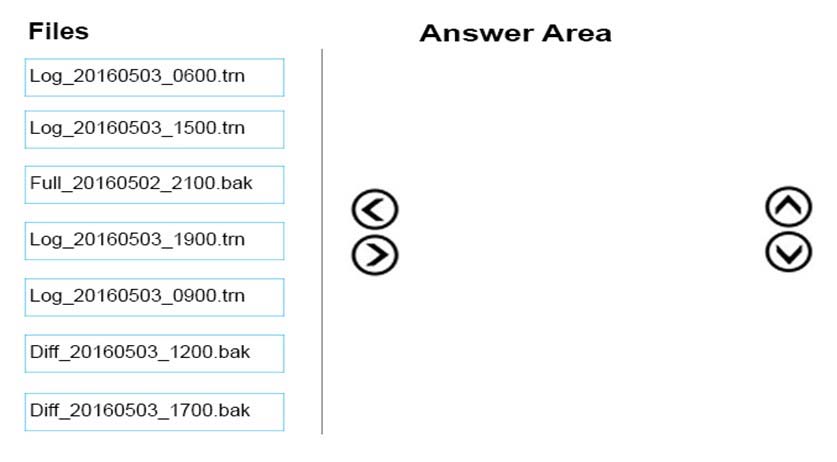
You have a database. The existing backups for the database and their corresponding files are listed in the following table.

You purchase a new server. You must restore the database to the new server.
You need to restore the data to the most recent time possible.
Which three files should you restore in sequence? To answer, move the appropriate files from the list of files to the answer area and arrange them in the correct order.
Select and Place:

Correct Answer:
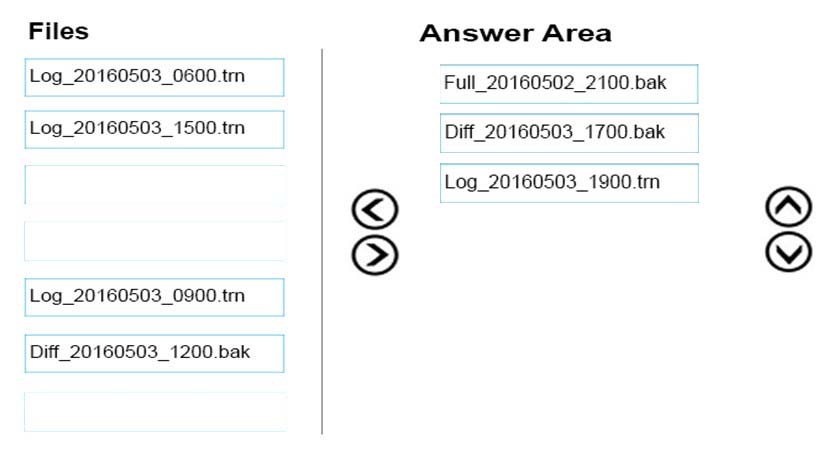
Step 1: Full.
Start with the full backup.
Step 2: Diff_20160503_1700.bak -
Followed by the most recent differential backup.
Step 3: Log_20160503_1900.bak -
And finally the most recent log backup (the only log backup done after the most recent differential backup).
References: https://docs.microsoft.com/en-us/sql/relational-databases/backup-restore/differential-backups-sql-server

Step 1: Full.
Start with the full backup.
Step 2: Diff_20160503_1700.bak -
Followed by the most recent differential backup.
Step 3: Log_20160503_1900.bak -
And finally the most recent log backup (the only log backup done after the most recent differential backup).
References: https://docs.microsoft.com/en-us/sql/relational-databases/backup-restore/differential-backups-sql-server
send
light_mode
delete
Question #35
A Microsoft SQL Server database named DB1 has two filegroups named FG1 and FG2. You implement a backup strategy that creates backups for the filegroups.
DB1 experiences a failure. You must restore FG1 and then FG2.
You need to ensure that the database remains in the RECOVERING state until the restoration of FG2 completes. After the restoration of FG2 completes, the database must be online.
What should you specify when you run the recovery command?
DB1 experiences a failure. You must restore FG1 and then FG2.
You need to ensure that the database remains in the RECOVERING state until the restoration of FG2 completes. After the restoration of FG2 completes, the database must be online.
What should you specify when you run the recovery command?
- Athe WITH NORECOVERY clause for FG1 and the WITH RECOVERY clause for FG2
- Bthe WITH RECOVERY clause for FG1 and the WITH RECOVERY clause for FG2
- Cthe WITH RECOVERY clause for both FG1 and FG2
- Dthe WITH NORECOVERY clause for both FG1 and FG2
Correct Answer:
A
A
send
light_mode
delete
Question #36
DRAG DROP -
You have a test server that contains a database named DB1. Backups of the database are written to a single backup device. The backup device has a full, differential, and transaction log backup.
You discover that the database is damaged. You restore the database to the point at which the differential backup was taken.
You need to rebuild the database with data stored in the latest transaction logs.
How should you complete the Transact-SQL statement? To answer. drag the appropriate Transact-SQL segments to the correct locations. Each Transact-SQL segment may be used once, more than once, or not at all. You may need to drag the split bar between panes or scroll to view content.
Select and Place:
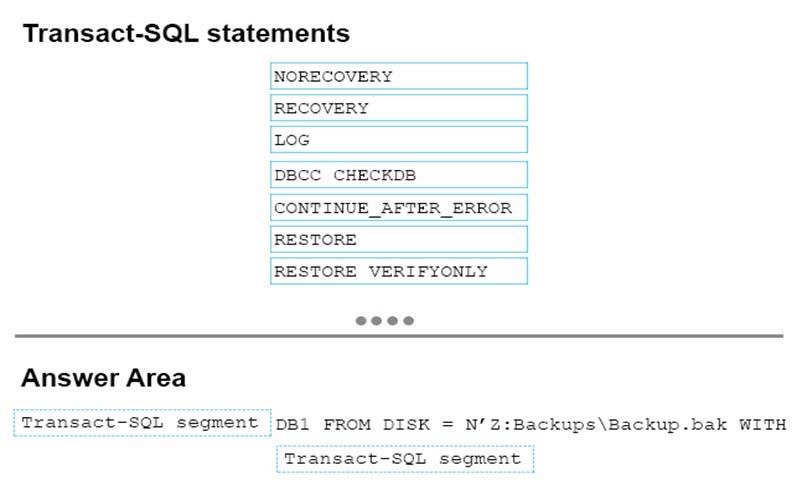
You have a test server that contains a database named DB1. Backups of the database are written to a single backup device. The backup device has a full, differential, and transaction log backup.
You discover that the database is damaged. You restore the database to the point at which the differential backup was taken.
You need to rebuild the database with data stored in the latest transaction logs.
How should you complete the Transact-SQL statement? To answer. drag the appropriate Transact-SQL segments to the correct locations. Each Transact-SQL segment may be used once, more than once, or not at all. You may need to drag the split bar between panes or scroll to view content.
Select and Place:

Correct Answer:
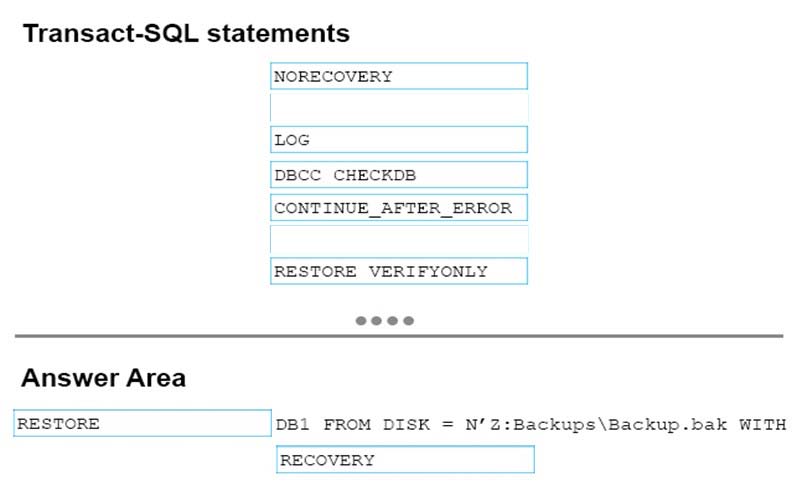
Box 1: RESTORE -
Box 2: RECOVERY -
The RESTORE ... WITH RECOVERY option puts the database into a useable state, so users can access a restored database.
References: https://www.mssqltips.com/sqlservertutorial/112/recovering-a-database-that-is-in-the-restoring-state/

Box 1: RESTORE -
Box 2: RECOVERY -
The RESTORE ... WITH RECOVERY option puts the database into a useable state, so users can access a restored database.
References: https://www.mssqltips.com/sqlservertutorial/112/recovering-a-database-that-is-in-the-restoring-state/
send
light_mode
delete
Question #37
You have a database named DB1 that is configured to use the full recovery model. You have a full daily backup job that runs at 02:00. The job backs up data from
DB1 to the file B:\DB1.bak.
You need to restore the DB1 database to the point in time of May 25, 2016 at 02:23 and ensure that the database is functional and starts to accept connections.
Which Transact-SQL statement should you run?

A.

B.

C.

D.
DB1 to the file B:\DB1.bak.
You need to restore the DB1 database to the point in time of May 25, 2016 at 02:23 and ensure that the database is functional and starts to accept connections.
Which Transact-SQL statement should you run?

A.

B.

C.

D.
send
light_mode
delete
Question #38
HOTSPOT -
You manage a Microsoft-SQL Server database named sales Orders.
You need to verify the integrity of the database and attempt to repair any errors that are found. Repair must not cause any data to be lost in the database.
How should you complete the DBCC command? To answer, select the appropriate options in the answer area.
Hot Area:
You manage a Microsoft-SQL Server database named sales Orders.
You need to verify the integrity of the database and attempt to repair any errors that are found. Repair must not cause any data to be lost in the database.
How should you complete the DBCC command? To answer, select the appropriate options in the answer area.
Hot Area:
Correct Answer:

Box 1: CHECKDB -
DBCC CHECKDB checks the logical and physical integrity of all the objects in the specified database.
Partial syntax:
DBCC CHECKDB -
[ ( database_name | database_id | 0
[ , NOINDEX
| , { REPAIR_ALLOW_DATA_LOSS | REPAIR_FAST | REPAIR_REBUILD } ]
.
Box 2: REPAIR_REBUILD -
DBCC CHECKDB REPAIR_ALLOW_DATA_LOSS | REPAIR_FAST |REPAIR_REBUILD specifies that DBCC CHECKDB repair the found errors.
REPAIR_REBUILD performs repairs that have no possibility of data loss. This can include quick repairs, such as repairing missing rows in non-clustered indexes, and more time-consuming repairs, such as rebuilding an index.
References: https://docs.microsoft.com/en-us/sql/t-sql/database-console-commands/dbcc-checkdb-transact-sql

Box 1: CHECKDB -
DBCC CHECKDB checks the logical and physical integrity of all the objects in the specified database.
Partial syntax:
DBCC CHECKDB -
[ ( database_name | database_id | 0
[ , NOINDEX
| , { REPAIR_ALLOW_DATA_LOSS | REPAIR_FAST | REPAIR_REBUILD } ]
.
Box 2: REPAIR_REBUILD -
DBCC CHECKDB REPAIR_ALLOW_DATA_LOSS | REPAIR_FAST |REPAIR_REBUILD specifies that DBCC CHECKDB repair the found errors.
REPAIR_REBUILD performs repairs that have no possibility of data loss. This can include quick repairs, such as repairing missing rows in non-clustered indexes, and more time-consuming repairs, such as rebuilding an index.
References: https://docs.microsoft.com/en-us/sql/t-sql/database-console-commands/dbcc-checkdb-transact-sql
send
light_mode
delete
Question #39
HOTSPOT -
You manage a Microsoft SQL Server environment. You have a database named salesOrders that includes a table named Table1.
Table1 becomes corrupt. You repair the table.
You need to verify that all the data in Table1 complies with the schema.
How should you complete the Transact-SQL code statement? To answer, select the appropriate Transact-SQL code segments in the dialog box in the answer area.
Hot Area:
You manage a Microsoft SQL Server environment. You have a database named salesOrders that includes a table named Table1.
Table1 becomes corrupt. You repair the table.
You need to verify that all the data in Table1 complies with the schema.
How should you complete the Transact-SQL code statement? To answer, select the appropriate Transact-SQL code segments in the dialog box in the answer area.
Hot Area:
Correct Answer:

Box 1: CHECKCONSTRAINTS -
DBCC CHECKCONSTRAINTS checks the integrity of a specified constraint or all constraints on a specified table in the current database.
Box 2: ALL_CONSTRAINTS -
ALL_CONSTRAINTS checks all enabled and disabled constraints on the table if the table name is specified or if all tables are checked;otherwise, checks only the enabled constraint.
Note: Syntax: DBCC CHECKCONSTRAINTS
[
(
table_name | table_id | constraint_name | constraint_id
)
]
[ WITH
[ { ALL_CONSTRAINTS | ALL_ERRORMSGS } ]
[ , ] [NO_INFOMSGS ]
]
References: https://docs.microsoft.com/en-us/sql/t-sql/database-console-commands/dbcc-checkconstraints-transact-sql

Box 1: CHECKCONSTRAINTS -
DBCC CHECKCONSTRAINTS checks the integrity of a specified constraint or all constraints on a specified table in the current database.
Box 2: ALL_CONSTRAINTS -
ALL_CONSTRAINTS checks all enabled and disabled constraints on the table if the table name is specified or if all tables are checked;otherwise, checks only the enabled constraint.
Note: Syntax: DBCC CHECKCONSTRAINTS
[
(
table_name | table_id | constraint_name | constraint_id
)
]
[ WITH
[ { ALL_CONSTRAINTS | ALL_ERRORMSGS } ]
[ , ] [NO_INFOMSGS ]
]
References: https://docs.microsoft.com/en-us/sql/t-sql/database-console-commands/dbcc-checkconstraints-transact-sql
send
light_mode
delete
Question #40
DRAG DROP -
You are configuring a new Microsoft SQL Server Always On Availability Group. You plan to configure a shared network location at \\DATA-CI1\SQL.
You need to create an availability group listener named AGL1 on port 1433.
In which order should you perform the actions? To answer, move all actions from the list of actions to the answer area and arrange them in the correct order.
Select and Place:
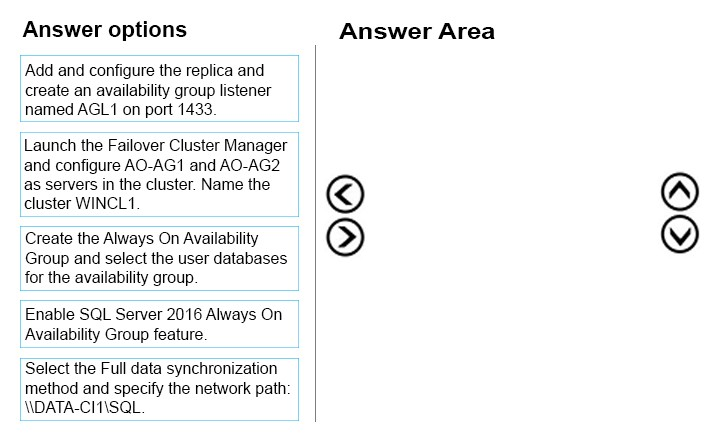
You are configuring a new Microsoft SQL Server Always On Availability Group. You plan to configure a shared network location at \\DATA-CI1\SQL.
You need to create an availability group listener named AGL1 on port 1433.
In which order should you perform the actions? To answer, move all actions from the list of actions to the answer area and arrange them in the correct order.
Select and Place:

Correct Answer:
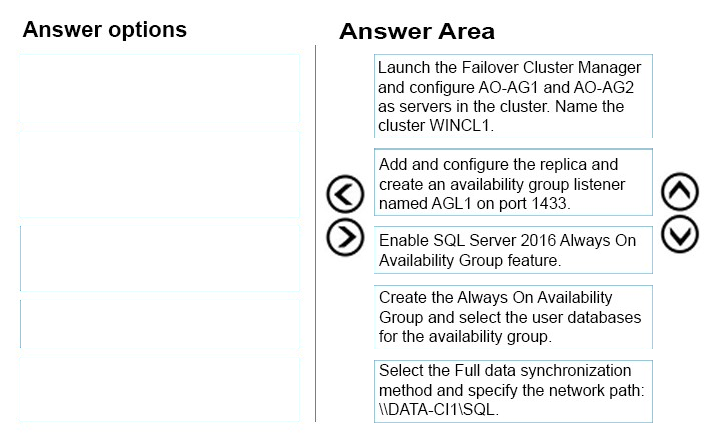
Step 1: Launch the Failover Cluster Manager and..
To support theAlways On availability groups feature, ensure that every computer that is to participate in one or more availability groups meets requirements including:
* Ensure that each computer is a node in a WSFC (Windows Server Failover Clustering).
Step 2: Add andconfigure the replica and
All the server instances that host availability replicas for an availability group must use the same SQL Server collation.
Step 3: Enable the SQL Server 2016 Always On Availability Group feature.
Enable the Always On availability groups feature on each server instance that will host an availability replica for any availability group. On a given computer, you can enable as many server instances for Always On availability groups as your SQL Server installation supports.
Step 4: Create the Always On Availability Group and..
Using Transact-SQL to create or configure an availability group listener
✑ Connect to the server instance that hosts the primary replica.
✑ Use the LISTENER option of the CREATE AVAILABILITY GROUP statement or the ADD LISTENER option of the ALTER AVAILABILITY GROUP statement.
Step 5: Select the Full data synchronization method and
References: https://technet.microsoft.com/en-us/library/jj899851(v=sc.12).aspx https://docs.microsoft.com/en-us/sql/database-engine/availability-groups/windows/create-or-configure-an-availability-group-listener-sql-server

Step 1: Launch the Failover Cluster Manager and..
To support theAlways On availability groups feature, ensure that every computer that is to participate in one or more availability groups meets requirements including:
* Ensure that each computer is a node in a WSFC (Windows Server Failover Clustering).
Step 2: Add andconfigure the replica and
All the server instances that host availability replicas for an availability group must use the same SQL Server collation.
Step 3: Enable the SQL Server 2016 Always On Availability Group feature.
Enable the Always On availability groups feature on each server instance that will host an availability replica for any availability group. On a given computer, you can enable as many server instances for Always On availability groups as your SQL Server installation supports.
Step 4: Create the Always On Availability Group and..
Using Transact-SQL to create or configure an availability group listener
✑ Connect to the server instance that hosts the primary replica.
✑ Use the LISTENER option of the CREATE AVAILABILITY GROUP statement or the ADD LISTENER option of the ALTER AVAILABILITY GROUP statement.
Step 5: Select the Full data synchronization method and
References: https://technet.microsoft.com/en-us/library/jj899851(v=sc.12).aspx https://docs.microsoft.com/en-us/sql/database-engine/availability-groups/windows/create-or-configure-an-availability-group-listener-sql-server
send
light_mode
delete
All Pages
